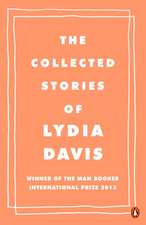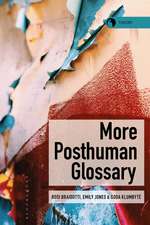Elegant Design: A Designer’s Guide to Harnessing Aesthetics
Autor Luca Iandoli, Giuseppe Zolloen Limba Engleză Paperback – 6 apr 2022
| Toate formatele și edițiile | Preț | Express |
|---|---|---|
| Paperback (1) | 147.96 lei 3-5 săpt. | |
| Bloomsbury Publishing – 6 apr 2022 | 147.96 lei 3-5 săpt. | |
| Hardback (1) | 505.55 lei 3-5 săpt. | |
| Bloomsbury Publishing – 6 apr 2022 | 505.55 lei 3-5 săpt. |
Preț: 147.96 lei
Preț vechi: 209.35 lei
-29% Nou
Puncte Express: 222
Preț estimativ în valută:
28.32€ • 30.75$ • 23.79£
28.32€ • 30.75$ • 23.79£
Carte disponibilă
Livrare economică 01-15 aprilie
Preluare comenzi: 021 569.72.76
Specificații
ISBN-13: 9781350174269
ISBN-10: 1350174262
Pagini: 200
Ilustrații: 150 colour illus
Dimensiuni: 210 x 270 x 12 mm
Greutate: 0.72 kg
Editura: Bloomsbury Publishing
Colecția Bloomsbury Visual Arts
Locul publicării:London, United Kingdom
ISBN-10: 1350174262
Pagini: 200
Ilustrații: 150 colour illus
Dimensiuni: 210 x 270 x 12 mm
Greutate: 0.72 kg
Editura: Bloomsbury Publishing
Colecția Bloomsbury Visual Arts
Locul publicării:London, United Kingdom
Caracteristici
Featuring case studies of elegant designs - such as the Instagram logo, the bicycle, Alessi homewares, and the first desktop computer, all illustrated in full-colour - demonstrates how the use of aesthetic criteria in design decisions is crucial in achieving both smart and beautiful designs
Notă biografică
Luca Iandoli is Associate Dean for Global Programs and Research and a professor in the Department of Computer Science at St. John's University. Luca was a Fulbright Visiting Scholar at the MIT Center for Collective Intelligence and served as associate professor at the University of Naples Federico II, Italy, and as visiting professor at Stevens Institute of Technology, USA. His research focuses on collective intelligence, interaction design, and product aesthetics.Giuseppe Zollo is Professor of Business and Management at the University of Naples Federico II, Schools of Engineering and School of Architecture, Italy. With a background in architecture and information science, Giuseppe's research focuses on complex systems, organizational learning and sense-making. His intellectual interests span from cognitive studies on art appreciation to history of science and technology.
Cuprins
PrefaceIntroductionThe age of aestheticsElegant decisionsThe art of simplicityGetting started1. The Simplifying MachineImpressionsSimple mindsWhat do you see is what do you get? Understanding as pattern recognitionThe joy of guessing: ambiguity and emotions in understandingThe role of aesthetic pleasure in understandingToo good to be trueCreativity Lab: how the mind simplifies reality and compresses information2. Beauty as Effective ComplexityThere is no recipe for creativityThe hidden workflow of the creative processHow does it feel? The roles of emotions in aesthetic experienceWhen good is good enough? Beautify as effective complexityStrategies for effective complexityConclusions: the necessity of artCreativity Lab: handling complexity in designPart One: Search for Unity Strategies3. Subtract DetailsThe art of concisionThe case for abstractionSubtracting the obvious, adding the meaningfulSmall talksThe science of brevityConclusionsCreativity Lab: subtracting details from your design without loosing meaningful performance4. SymmetryBlood, sweat, and tears: what goes up, can't go downThe invention of the point of view: symmetry in artManaging symmetry: checks and balancesThe science of symmetryConclusionsCreativity Lab: how to handle symmetry and asymmetry in your design5. The Power of GroupingA stroll down the memory laneThe power of grouping in art: seeking as creatingWhat is your product? The danger of cognitive inertia and the wonders of creative categorizationThe science of groupingConclusionsCreativity Lab: Effectively grouping information in your design6. SplitLizards, infinite lawns, and the invention of the hypertextThe devil is in the detailThe ergonomics of simplicity: the NEST thermostatThe science of splitConclusionsCreativity Lab: how to design effective information layers and hierarchyPart Two: Push for Variety Strategies7. The Power of the CenterMay the force be with youThe power of the center in art: equilibrium as dynamic tensionThe power of obsession: how extreme focus can make your business thrive (or die)The science of split: the eye of the beholderConclusionCreativity Lab: identifying attention-structuring centers in your design8. EmphasizeAn umbrella on four wheelsEmphasize in artThink different: emphasize in design and managementThe science of emphasizingCreativity Lab: how to make your design stand out by harnessing the power of emphasis9. RemixMission ImpossibleMetamorphosis or the Nature of ChangeWhat's your story? A chairman walks into a labThe science of remixConclusionsCreativity Lab: effectively reshuffling your design to search for novelty10. Contrast and BalanceChess and balancePresent, tenseLost in transitionThe science of contrastConclusions: keep on movingCreativity Lab: How to creative effective visual weight dynamics11. The Swinging MindBlack holes and supernovas: navigating the design continuumThe critical role of granularity in designWhen good is good enough: the swinging mindDesign as persuasionCreativity Lab: everyday exercises to cultivate a swinging mindConclusionIndex
Recenzii
By exploring the tensions between simplicity and complexity, Luca Iandoli and Giuseppe Zollo, have masterfully developed a set of methods explaining the basic concepts of design through the analysis of art and psychological theories, leading to their application to produce innovative product design.



























